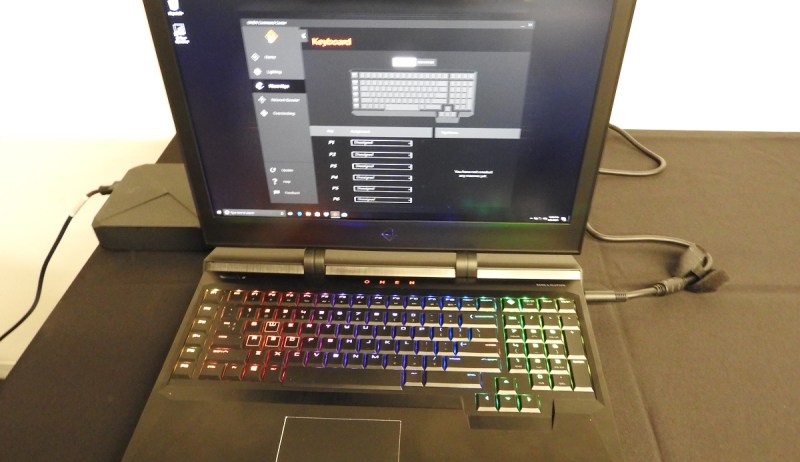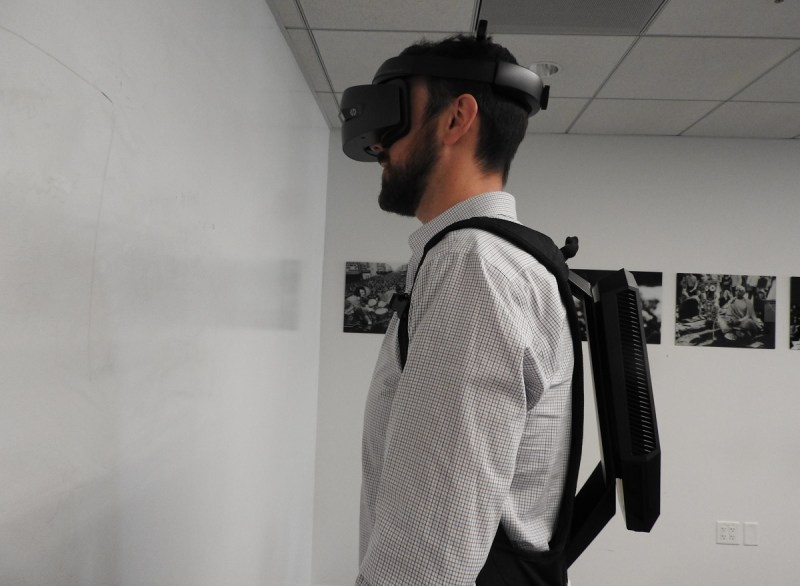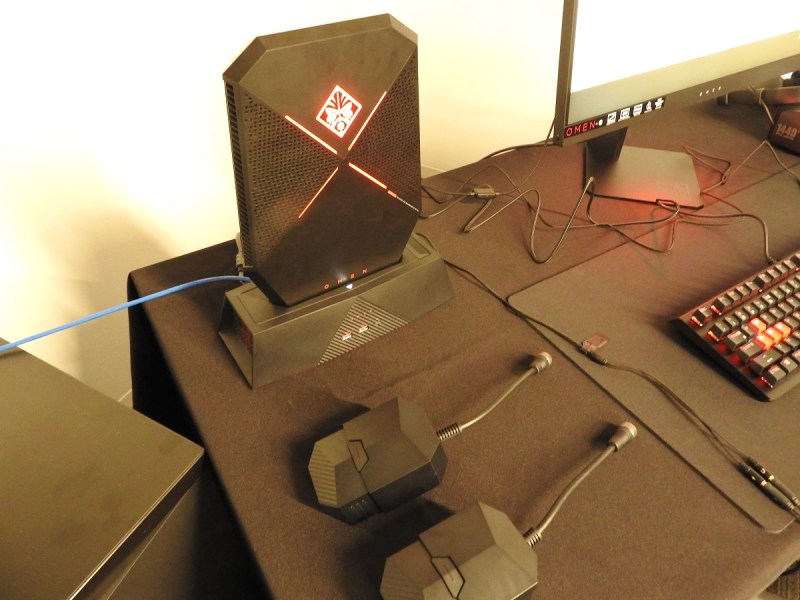
Above: HP’s latest Omen laptop has a keyboard with mechanical switches that gamers like.
You saw us do more and more things to build in our desktops, and increasingly in our notebooks, the GPU and CPU power to make that possible. A great example of that, we launched the new Omen X notebook about a week ago. We have two lines in Omen. Omen is about great price and performance for gamers, but for the enthusiast who’s looking for maximum performance, the Omen X DNA is about overbuilding, about maximum performance without compromise.
The question was, how do you get some of the features that were historically only available in a desktop into a notebook? This notebook has an overclocked GPU, overclocked memory, a K-series Intel processor that can be overclocked as well. But our insights told us that most customers who bought K-series processors, about 70 percent of them, never overclocked. It was too hard to figure out how to do that. You had to go into the BIOS or use a bunch of different applications. With this version, we also have a new piece of software called Omen Command Center. That lets you control the lighting on the device, the macro keys, all the various aspects of the device, and also gives you a one-stop place to go in and tune your PC and make sure you can overclock to get the maximum performance.
This is no light machine. But most of the time it’s being carried from place to place. Check out the keyboard. It’s a full 22 millimeter action keyboard. It has the clickiness that gamers expect on this kind of device. Very purpose-built for someone who wants to game all day long with no compromise.
VB: Has Windows 10 figured out their thermal problems yet?
Coughlin: I don’t think it’s Windows 10’s job to do. That’s something HP spends a lot of time on. We have some phenomenal mechanical and electrical engineers who’ve gone through this device to make it really overbuilt. The heat pipes in this device let us run a K-series processor over spec. We can take 1080GTX GPUs and overclock them by default. We’re not scaling back. We’re running things beyond spec. It’s our ability to solve things like that with our engineering prowess that’s allowed our gaming business to grow 10 times in the last two years.
On the backpack, this is very interesting. We announced it a year before we launched it. We wanted to see if the ecosystem really wants this. Again, much more hands-on insight in the design thinking, to really see where they saw it going. As we said, one of the big pieces of feedback was, we built it for consumer and gaming, but we got a lot of interest from commercial and other vertical applications.
The key innovations here — first of all, a backpack that moves heat away from the user. Even with the prototype, we found that too much heat was heading toward the person’s back. The design changed pretty dramatically. The whole notion of these high-output batteries was a critical part of that. Putting a notebook in a backpack isn’t that complicated. Running the notebook like it’s plugged in all the time is harder. These high-voltage output batteries were a big part of that. You can hot swap them. The computer has a battery in it, so when these batteries die, you pop them out, charge them, and put in a fresh set without rebooting the system.
We also got feedback that said when it’s not being worn as a backpack, it’s awkward to have it lying on a table. We built in this docking station that allows you to take the backpack off the straps, pop in here, and use it as a full desktop with all the ports you want running right to the screen.
For the gaming space we spent a lot of time with accessories to make sure the experience was complete. We just launched the new Omen keyboard. It uses blue switches, the full clicky feel that customers expect. We’re also supporting, across our line, 26-key rollover. If you have multiple key presses at the same time, on a regular notebook we don’t capture that, but in a gaming notebook you don’t want your weapons to go up just because you’re shooting. We also heard feedback from some customers that said our mouse was too light or too heavy. We’ve designed the mouse so you can open it up and take weights in and out, so it’s exactly how you want it every day.

Above: HP’s VR headset and backpack with attached laptop.
VB: Did you guys announce a price for this yet?
Coughlin: Yes, it’s $449, with hand controls. In the VR space in particular, we spent a lot of time with HTC, but we’re also supporting Oculus in our configurations. We’re very much invested in our partnership with Microsoft in this space as well. This is the forthcoming headset from HP that works as part of the holographic platform. A few things you’ll notice about ours, compared to some of the others out there — a lot of work’s been done to weight it and make it adjustable. You can adjust it from behind. It works with different head shapes and sizes, but also, the weight is centered so you don’t feel it pulling on the back of your head. It’s going to have a much more aggressive price point than HTC and Oculus, so it’ll put more sockets out there, which will get more developers building great VR content.
VB: There’s some concern that either people with glasses — it’ll fog up the inside lenses, if you stay in it for about an hour.
Coughlin: We haven’t seen that yet, in a lot of testing. We do a lot of ergonomics and human factors work, and we’ve not seen that. Our lead person on VR, Spike, wears this thing all day long with his glasses.
What you see us doing is building out, when you talk about commercial. Where we’re stabilizing — like I said, we got calls for the workstation team. Where we see a big opportunity, a more than $10 billion market, is commercial VR. Given our commercial legacy — number one in commercial PCs for multiple years — we’re now taking this and creating a Z version. We’re working with automakers on design and troubleshooting. We’re working in the medical field, in education contexts. We’re working in manufacturing. Military training is a perfect example. We’re excited about the commercial VR opportunity. It’s much less crowded there.
It’s about cases where you need to create an experience that would be expensive to replicate in a physical space. You’re doing an anatomy class. Cadavers are expensive, a lot of overhead associated with that. I can do that training and watch what you’re doing to see if you made the cut properly and give you feedback. That’s not a concept. They’re teaching anatomy today at Case Western to first-year med students in VR.
VB: Is that a classroom full of these things, then?
Coughlin: They have 12 or 15 folks in the class. It’s a different kind of lab. My favorite is — I don’t know how old you are, but when I went to school we’d have these big bulky textbooks on Roman history and you’d see a picture of the Colosseum. If you have VR, all of a sudden you’re in the Colosseum. You’re experiencing this place.
VB: It seems like VR, in that kind of case, needs a one-to-many sort of experience. One computer talks to 30 visors.
Coughlin: One of the experiences in particular that the Microsoft platform is focusing on is this notion of one-to-many and collaboration. The question is, is collaboration a key opportunity for VR? We’re seeing that in some gaming experiences as well. A lot of problems are being solved in gaming that end up having applications in the commercial space. We see that a lot in general, but in an even more concentrated way in VR.
We have a lot of momentum and we’re excited about what we’re doing on our core, things like device as a service, and then VR and immersive computing.

Above: HP’s VR computer can be used as a desktop or be worn in a backpack.
VB: I saw you guys joined as a co-investor in the Venture Reality Fund. That tells me there’s some seriousness here about VR. At some point you decided it’s on the right trajectory. How did that come about?
Coughlin: Let me address that on multiple levels. If you look at the two years we’ve been an independent company, what’s interesting is — I’ve been with the company 10 years. The first company we bought was a 3D scanning company called David Laser. Small acquisition, technology acquisition, those are the types of things you used to hear about Intel or Apple doing. That wasn’t the type of stuff we were doing around our PC business.
One, that’s a great feature of us being a focused stand-alone company. Then VR, similarly, came from CTO’s office. My team said, “Hey, we want to go after VR.” They said, “Let’s find out who’s doing interesting things. How do we tap into the cutting edge of VR development?” We evaluated the opportunity and saw that this is what we wanted to do. Both of those are testaments to a shift from a commodity bundler of Microsoft and Intel to a company dedicated to providing its own IP, developing its own IP.
Again, technology for the sake of technology, we see that a lot. In this case the decisions are based on seeing a real customer problem, based on feedback we heard through telemetry or in a conversation. We understand the root cause of what the customer wants and either found — like in the David Laser example – or invented to fill the gaps and make sure we had the complete experience. The VR Fund is partly to just expose us, so we know where the industry’s going and if there are opportunities for us to partner or buy technology to pursue those.
VB: Does it concern you at all that the consumer acceptance of VR is slower than expected? The sales are not on the steepest curve.
Coughlin: First, that’s why it’s in our future bucket and not in our core. Our future bucket, we’re patient. We’re letting technology play out. A perfect example is immersive computing, where we started in consumer, created a new UI, and then realized, “Okay, the magic is in commercial and 3D scanning.” The nature of future is we’re evolving the technology as we interface with customers.
Two, that headset right there, we’re selling it for holiday. We’re sold in. I will tell you that I expected dribs and drabs of orders. It won’t change the over $30 billion number for Q4, but it is not insubstantial in terms of the numbers that have been ordered. Not projected, but ordered from retailers. It’s more scale than I expected it to be.

